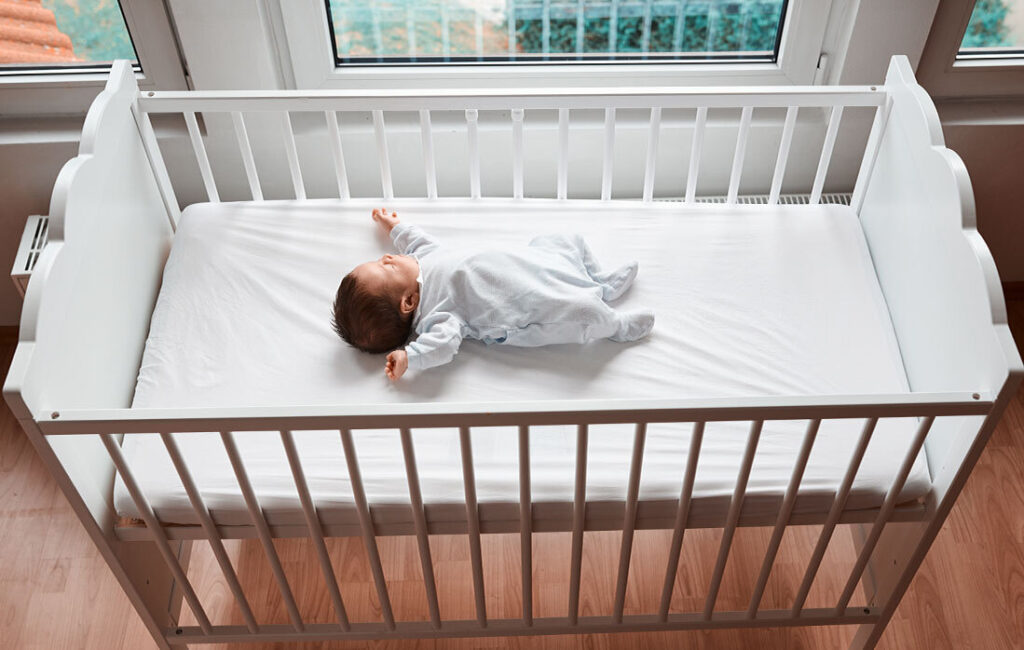
Here at Sleepopolis, we love giving you the inside scoop on what mattress could work best for your sleeping position and body type. But when it comes to crib mattresses, babies don’t get to choose. It’s up to the parent to provide a bed that’s both comforting and safe for the child.
Crib mattresses work a bit differently than mattresses meant for adults, since infants and adults have different sleep needs. Does this mean they don’t last as long? In this guide, I’ll go over everything you need to know about a crib mattress’s lifespan, when to retire it, and how to make it last even longer.
Crib Mattress Lifespan Factors
If you’re wondering if it’s time to retire your crib mattress, there are a few different factors you can consider.
Recalls
Just like any product, there’s the potential that a crib mattress may get recalled. Luckily, all crib mattresses should come with tracking information. It should provide the name of the manufacturer, where and when it was made, what batch it came from, and other specific info on the mattress’s source. You can use this information to check for recalls online and be sure that it hasn’t been declared defective.
Age
What classifies a mattress as “old” is different for crib mattresses than for adult mattresses. Generally, a regular mattress may need to be updated after about 10 years. However, a crib mattress is typically past its point of good use after five years.
Type and Materials
Like any mattress, crib mattresses will last longer if they’re made from high-quality materials. Typically, innerspring mattresses are pretty durable — just make sure to check that the springs aren’t poking out. Foam mattresses also hold up pretty well, but the type of foam can determine its longevity. High-density foam won’t lose its shape as quickly and cause indentations like low-density memory foam can.
A mattress that has a high-quality cover will also last the longest. If you want to use this mattress for years, it’s best to get one that is durable and can withstand stains.
It’s important to note that the American Academy of Pediatrics warns against memory foam crib mattresses. The mattress must not have indentations or sag. A firmer mattress is typically best for babies because mattresses that are too soft or have indentations can put the baby at risk for suffocation or Sudden Infant Death Syndrome (SIDS).
Fit
Making sure the mattress fits the crib properly is an important factor in making it last longer. Cribs are usually standard-sized, but there are exceptions. Double-check that the crib mattress fits by making sure there isn’t more than two fingers’ width of space between the side of the mattress and the crib frame. You don’t want the bed to slide around in the crib or for the baby to get caught in the gaps.
Resistance to Liquids
Let’s keep it real — babies have accidents. It’s totally normal for crib mattresses to get peed on and spit up on. It’s unavoidable, so it’s a good idea to look for one that is either waterproof or liquid-repellent to help lengthen its lifespan. Getting a waterproof mattress protector is also a way to add extra protection.
Resistance to Stains
We already mentioned that accidents on crib mattresses are inevitable, and so are the stains that come with them. Stains can not only make the mattress seem dirty but can also pose health risks and make the mattress warranty void. If it doesn’t come with an easily washable cover, you may want to think about that mattress protector.
Signs A Crib Mattress Shouldn’t Be Used
If you already have a crib mattress and are wondering if it’s still okay to use, there are a few easy ways to tell if its better days are in the past.
Wear and Tear
The easiest way of telling if a mattress should be replaced is by doing a visual inspection for wear and tear. This is especially important if it’s an innerspring mattress. If you see a coil poking out, get rid of it immediately — you don’t want the child getting hurt. Loose threads and rips are also good indicators that the bed is coming apart. Plus, loose threads are also choking hazards.
Indentations or Lumps
If your crib mattress is made of low-density memory foam, you’ll want to check it often and make sure there are no indentations. Indentations are not only uncomfortable for a baby but also prevent them from moving around, which can put them at risk. Remember, the American Academy of Pediatrics warns against memory foam crib mattresses for just this reason.
Firmness
Feel the mattress and make sure it hasn’t gone soft or flat. The bed should be on the firmer side in order to keep the child properly supported and allow them to move around. If the mattress is too soft, the child is at risk of being trapped.
Cleanliness
When was the last time the mattress was cleaned? Is it free of bacteria, mold, mildew, and fungus? If you notice the mattress has suspicious stains, smells, or growths, then it’s best to replace it. It’s not worth risking exposing the child to harmful pathogens that can cause respiratory issues and raise the risk of SIDS.
How to Make a Crib Mattress Last Longer
The best way to ensure your crib mattress lasts a long time is to take proactive steps to preserve it. Here are a few ways to prevent your mattress from getting worn out too quickly:
- Get a mattress protector: Mattress protectors or some other form of protective cover will make your life much easier when it comes to cleaning liquids and spills.
- Clean quickly: When an accident does happen, clean it ASAP. Don’t let the stain sit there for too long and seep even further into the mattress.
- Clean regularly: You wouldn’t go a long time without cleaning your clothes, so don’t go a long time without cleaning your baby’s mattress. The mattress should be a clean space for the baby to sleep and relax.
- Make sure it’s dry: Don’t put bedding on the crib until it is completely dry. Putting sheets on a damp mattress can trap the moisture and cause mildew to fester.
- Turn or flip it: First, be sure that the mattress is able to be flipped/turned — meaning it doesn’t have top-down layering. Turning and flipping the mattress regularly can prevent the baby from sleeping too long in one spot, which causes dangerous indents.
- Store it properly: If you’re not currently using the mattress but want to save it for a future child, be sure to store it well to keep it preserved. Ideally, you should wrap it in plastic or box it up and store it in a temperature-regulated environment.
FAQs
Can you reuse a crib mattress for a second baby?
As long as the crib mattress is in good condition, it can be passed down to another child. Just be sure it is clean and check for signs of damage, such as tears or indentations, before use.
How long do infant crib mattresses last?
The longevity of a crib mattress depends on the quality of the mattress and how much it’s been through. But a good standard is about five years.
Can you use the same mattress for a second child?
As long as the crib mattress is in good condition, it can be passed down to another child. Just be sure it is clean and check for signs of damage before use.
Is it okay to use an old crib mattress?
Yes, as long as it’s not damaged or worn out. Check for indentations and lumps as well as for stains and tears.
Do crib mattresses have an expiration date?
Your crib mattress won’t come with an expiration date on its tag. Its longevity is determined by its materials and the way it’s been treated.
Are all crib mattresses the same size?
Usually, a crib mattress is a standard size. It is 27 inches by 51 inches. However, there are some mini versions that are 24 inches by 38 inches.
Conclusion
As a parent, it’s your responsibility to ensure the comfort and safety of your child. With the right crib mattress, your baby can sleep soundly, which means you can, too.
Sources
- Moon R. Sleep-Related Infant Deaths: Updated 2022 Recommendations for Reducing Infant Deaths in the Sleep Environment. Publications.aap.org. https://publications.aap.org/pediatrics/article/150/1/e2022057990/188304/Sleep-Related-Infant-Deaths-Updated-2022?autologincheck=redirected. Published June 21, 2022.
- Recalls. U.S. Consumer Product Safety Commission. https://www.cpsc.gov/Recalls?tabset=on&field_rc_hazards_target_id=All&field_rc_recall_by_product_target_id=2791.
- Sudden Unexpected Infant Death and Sudden Infant Death Syndrome. 29 Sept. 2022, https://www.cdc.gov/sids/index.htm.



























